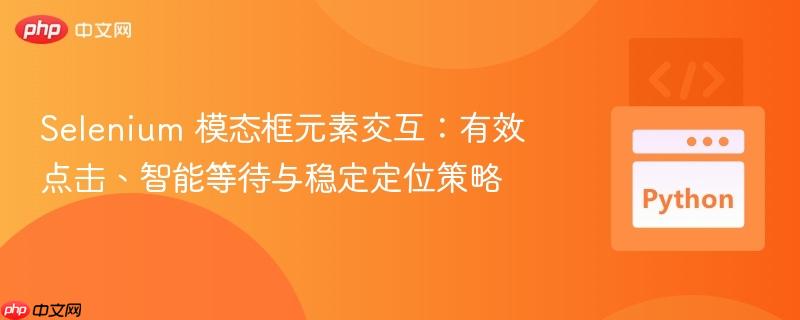
在 selenium 自动化测试中,与网页上的模态框进行交互是常见的场景。然而,由于模态框通常是动态加载的,并且其触发按钮可能包含复杂的 javascript 逻辑(如防抖),这使得定位和操作模态框内的元素变得具有挑战性。常见的错误包括:
许多初学者倾向于使用浏览器开发者工具生成的绝对 XPath (例如 /html/body/div[4]/div/div/div[2]/div[2]/div/div[2]/form/div[1]/div[1]/div/input) 来定位元素。这种方法虽然在短时间内可能有效,但一旦页面结构发生微小变化,绝对 XPath 就会失效,导致 NoSuchElementException。绝对 XPath 不具备可维护性,应尽量避免。
简单地使用 time.sleep() 来等待元素加载是不可靠的。页面的加载速度受网络、服务器响应和客户端渲染等多方面因素影响,固定的等待时间可能过长(浪费时间)或过短(导致元素未加载而失败)。
更重要的是,某些按钮(尤其是触发模态框的按钮)可能实现了防抖(Debounce)逻辑。这意味着即使你点击了按钮,其关联的事件处理程序并不会立即执行,而是会在一定延迟后执行,或者在短时间内多次点击只触发一次。在这种情况下,即使 time.sleep(2) 这样的固定等待,也可能因为防抖逻辑未结束而导致模态框未能及时弹出,进而无法定位到模态框内的元素。
为了克服上述挑战,我们需要采用更智能、更健壮的策略来处理模态框的交互。
放弃使用绝对 XPath,转而采用更稳定、更具描述性的定位器:
使用 Selenium 的 WebDriverWait 和 expected_conditions 模块来智能等待元素:
这些显式等待会周期性地检查条件是否满足,直到超时或条件满足,从而避免了 time.sleep() 的不确定性。
针对按钮可能存在的防抖逻辑,可以实现一个带重试机制的点击函数。该函数会尝试点击按钮,然后短暂等待并检查模态框是否成功弹出。如果未弹出,则重试点击,直到达到最大重试次数或模态框成功显示。
from selenium import webdriver
from selenium.webdriver.common.by import By
from selenium.webdriver.support.ui import WebDriverWait
from selenium.webdriver.support import expected_conditions as EC
import time
def click_and_wait_for_modal_with_retry(driver, max_retries, button_locator, modal_locator_by, modal_locator_value):
"""
点击按钮并等待模态框出现的重试函数。
Args:
driver: WebDriver 实例。
max_retries: 最大重试次数。
button_locator: 触发模态框的按钮定位器(元组,如 (By.CSS_SELECTOR, 'button_selector'))。
modal_locator_by: 模态框的定位方式(如 By.CSS_SELECTOR)。
modal_locator_value: 模态框的定位值(字符串)。
"""
retries = 0
while retries < max_retries:
# 1. 等待按钮出现并可点击
button = WebDriverWait(driver, 10).until(EC.element_to_be_clickable(button_locator))
button.click()
# 2. 短暂等待,给防抖逻辑和模态框加载留出时间
time.sleep(0.5)
# 3. 检查模态框是否已显示
# 使用 find_elements 避免在模态框未出现时抛出 NoSuchElementException
modal_elements = driver.find_elements(modal_locator_by, modal_locator_value)
if len(modal_elements) > 0 and modal_elements[0].is_displayed():
print(f"模态框在第 {retries + 1} 次尝试后成功显示。")
return
print(f"模态框未显示,进行第 {retries + 1} 次重试...")
retries += 1
raise Exception(f'达到最大重试次数 {max_retries},模态框仍未显示。')
下面是一个完整的示例,演示如何使用上述策略来自动化操作一个包含防抖点击和内部输入框的模态框。
import time
from selenium import webdriver
from selenium.webdriver.common.by import By
from selenium.webdriver.support.ui import WebDriverWait
from selenium.webdriver.support import expected_conditions as EC
# 1. 初始化 WebDriver
driver = webdriver.Chrome()
wait = WebDriverWait(driver, 20) # 全局显式等待,最长20秒
driver.maximize_window()
# 2. 导航到目标 URL
target_url = 'https://www.portalinmobiliario.com/MLC-2148268902-departamento-los-espinos-id-116373-_JM#position=1&search_layout=grid&type=item&tracking_id=eba8327b-85c0-4317-8c63-7c69c5b34e16'
driver.get(target_url)
try:
# 3. 处理 Cookie 同意弹窗(如果存在)
# 等待 Cookie 同意按钮出现并点击
consent_button_locator = (By.ID, 'newCookieDisclaimerButton')
consent = wait.until(EC.presence_of_element_located(consent_button_locator))
consent.click()
# 等待 Cookie 弹窗消失(变得陈旧)
wait.until(EC.staleness_of(consent))
print("成功处理 Cookie 同意弹窗。")
# 4. 使用重试机制点击“联系”按钮并等待模态框出现
# 触发模态框的按钮定位器
contact_button_locator = (By.CSS_SELECTOR, 'button[type=primary] .andes-button__content')
# 模态框的定位器
modal_overlay_locator = (By.CSS_SELECTOR, '.andes-modal__overlay')
click_and_wait_for_modal_with_retry(
driver,
max_retries=5, # 最多重试5次
button_locator=contact_button_locator,
modal_locator_by=By.CSS_SELECTOR,
modal_locator_value='.andes-modal__overlay'
)
print("成功点击联系按钮并等待模态框出现。")
# 5. 在模态框内部定位元素并进行交互
# 等待模态框本身可见
dialog = wait.until(EC.visibility_of_element_located(modal_overlay_locator))
# 为模态框内部的元素创建一个新的 WebDriverWait 实例,作用域限定在模态框内
# 这可以提高定位的准确性,避免与页面上其他同名元素混淆
modal_wait = WebDriverWait(dialog, 10)
# 定位模态框内的姓名输入框并输入
name_input_locator = (By.CSS_SELECTOR, '[data-testid=name-input]')
name_input = modal_wait.until(EC.visibility_of_element_located(name_input_locator))
name_input.send_keys('自动化测试用户')
print("成功在模态框内输入姓名。")
# 假设还有其他输入框,例如电话和邮箱
# phone_input_locator = (By.CSS_SELECTOR, '[data-testid=phone-input]')
# phone_input = modal_wait.until(EC.visibility_of_element_located(phone_input_locator))
# phone_input.send_keys('1234567890')
# email_input_locator = (By.CSS_SELECTOR, '[data-testid=email-input]')
# email_input = modal_wait.until(EC.visibility_of_element_located(email_input_locator))
# email_input.send_keys('test@example.com')
# 可以继续定位并点击提交按钮等操作
# submit_button_locator = (By.CSS_SELECTOR, '.andes-modal__footer button[type=submit]')
# submit_button = modal_wait.until(EC.element_to_be_clickable(submit_button_locator))
# submit_button.click()
# print("成功提交模态框表单。")
time.sleep(3) # 演示停留,实际测试中应移除或替换为等待条件
except Exception as e:
print(f"发生错误: {e}")
finally:
# 6. 关闭浏览器
driver.quit()
print("浏览器已关闭。")
遵循这些最佳实践,您将能够更有效地处理 Selenium 自动化测试中的模态框交互,编写出更稳定、更可维护的测试脚本。
以上就是Selenium 模态框元素交互:有效点击、智能等待与稳定定位策略的详细内容,更多请关注php中文网其它相关文章!

每个人都需要一台速度更快、更稳定的 PC。随着时间的推移,垃圾文件、旧注册表数据和不必要的后台进程会占用资源并降低性能。幸运的是,许多工具可以让 Windows 保持平稳运行。

Copyright 2014-2025 https://www.php.cn/ All Rights Reserved | php.cn | 湘ICP备2023035733号